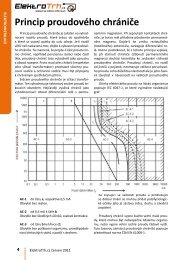Develop a time stamping application in PlantStruxure? - Schneider ...
Develop a time stamping application in PlantStruxure? - Schneider ...
Develop a time stamping application in PlantStruxure? - Schneider ...
Create successful ePaper yourself
Turn your PDF publications into a flip-book with our unique Google optimized e-Paper software.
1-Introduction<br />
Table 1 Synchronization between the clock reference and <strong>time</strong> clock<br />
Time stamps on the event data – performs the <strong>time</strong> <strong>stamp<strong>in</strong>g</strong> function.<br />
The PAC system records the <strong>time</strong> data with the <strong>time</strong> clock when the event occurs and<br />
associates the <strong>time</strong> <strong>in</strong>formation with the event signal data.<br />
Monitor<strong>in</strong>g & data <strong>in</strong>quiry – manages the <strong>time</strong> stamped data.<br />
The <strong>time</strong> stamped data is displayed and recorded on the SCADA system. The <strong>time</strong><br />
stamped data can be used <strong>in</strong> different <strong>application</strong>s such as sequence of events (SOE)<br />
and alarm signals. The data history helps the user to analyze the event sequence.<br />
1.2.3 Benefits of a <strong>time</strong> <strong>stamp<strong>in</strong>g</strong> <strong>application</strong><br />
Time <strong>stamp<strong>in</strong>g</strong> <strong>in</strong> automation systems helps with process control and ma<strong>in</strong>tenance by<br />
add<strong>in</strong>g a <strong>time</strong>stamp to every event.<br />
In a complex automation system, many events can cause the system to error and<br />
stop the system. Because of the mass of <strong>in</strong>formation the system provides when<br />
stopp<strong>in</strong>g, f<strong>in</strong>d<strong>in</strong>g useful <strong>in</strong>formation can be tricky. Time <strong>stamp<strong>in</strong>g</strong> provides a way of<br />
order<strong>in</strong>g the <strong>in</strong>formation with <strong>time</strong> stamps mak<strong>in</strong>g it simpler to track errors..<br />
For example, suppose four discrete events -A, B, C, and D as shown <strong>in</strong> Figure 2<br />
impact on each other. A detected error <strong>in</strong> one of the events can trigger a cha<strong>in</strong><br />
reaction prevent<strong>in</strong>g the other three from runn<strong>in</strong>g successfully and result<strong>in</strong>g <strong>in</strong> an<br />
emergency stop.<br />
If there are no <strong>time</strong> stamps on the event records, it becomes very difficult to say<br />
which of the events caused the stop.<br />
With the <strong>time</strong> <strong>stamp<strong>in</strong>g</strong> function, the events are sequentially recorded with <strong>time</strong><br />
<strong>in</strong>formation, enabl<strong>in</strong>g quicker and easier ma<strong>in</strong>tenance as the user can see which of<br />
the events started the cha<strong>in</strong> reaction that caused the system to stop.<br />
This is the benefit of the <strong>time</strong> <strong>stamp<strong>in</strong>g</strong> function <strong>in</strong> a complex system.<br />
11

















